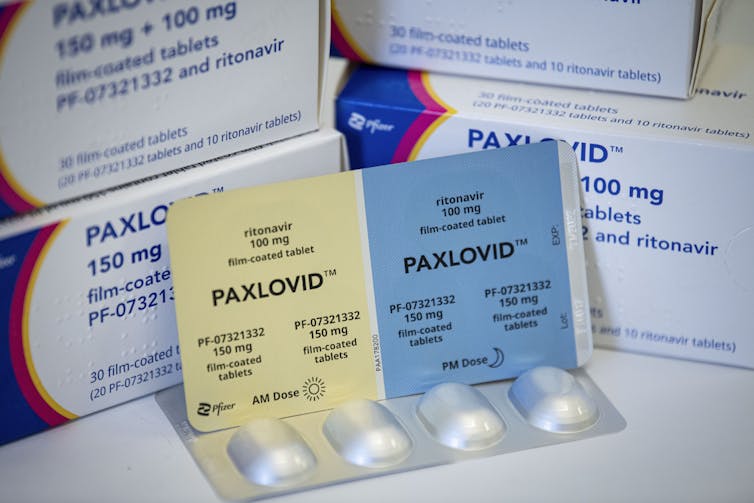
Biden tests positive for COVID-19: An infectious disease doctor explains the risks and treatments available for the 79-year-old president

Patrick Jackson, University of Virginia
On July 21, 2022, U.S. President Joe Biden said he had tested positive for COVID-19 and was experiencing mild symptoms. In a letter to the public, Biden’s doctor explained that the president had a slight runny nose, some fatigue and the occasional dry cough, and that Biden had already begun taking the antiviral drug Paxlovid. Patrick Jackson, an assistant professor of infectious diseases at the University of Virginia, explains the risks that someone like Biden faces from a bout of COVID-19 and the treatments available.
1. What are the important risk factors for Biden?
The most important risk factor for developing severe COVID-19 is age. If you are 79 years old when you become infected with COVID-19, like President Biden, you are eight times more likely to become hospitalized and 140 times more likely to die compared with someone who gets COVID-19 at age 20. Preexisting health conditions – like obesity, cancer and chronic kidney or lung disease – also increase the risk of severe illness. But Biden is reported to be fairly healthy.
Fortunately, preexisting immunity from vaccination or from a previous episode of COVID-19 is highly protective against severe disease. Researchers only have limited data on the BA.5 variant that is responsible for most recent COVID-19 cases in the U.S. – and likely Biden’s, too – but the level of protection from vaccines is likely similar to that of the previous strains BA.1 and BA.2. While the BA.1 and BA.2 omicron variants of SARS-CoV-2 were very adept at infecting people who are vaccinated and boosted, the data shows that prior immunity from vaccines provides strong protection against severe or fatal disease. During the first omicron wave in California, COVID-19 patients who did not have immunity from vaccination or previous infection were much more likely to be hospitalized, be admitted into an intensive care unit or die compared with people who were vaccinated and boosted.
2. What is the first line of treatment for someone like Biden, and why?
Current best medical practice is to give antiviral treatments to patients who have recently developed mild to moderate COVID-19 symptoms and are at higher risk of severe illness. The goal of antivirals is to stop the virus from replicating in the body in order to prevent hospitalization or death.
Currently there are four antiviral drugs available in the U.S. for the treatment of COVID-19 in outpatients: nirmatrelvir-ritonavir, better known by the brand name Paxlovid, remdesivir, bebtelovimab and molnupiravir. The best drug for a particular patient depends on preexisting health conditions, accessibility and drug interactions with other medications. Paxlovid is widely used because it was shown to be highly effective in a clinical trial and is available in pill form.

3. How does Paxlovid work, and what are its shortcomings?
Paxlovid is an oral antiviral drug that is used to treat some patients with mild to moderate COVID-19 who do not require hospitalization. Paxlovid is a combination of two medications. One is nirmatrelvir, a drug that works by disrupting the coronavirus’ ability to make functioning proteins. The other is ritonavir, an HIV drug that boosts the level of nirmatrelvir in the blood by blocking an enzyme in the liver that breaks down nirmatrelvir.
A clinical trial of Paxlovid showed that the drug significantly reduces the risk of hospitalization or death when given to infected patients within five days of their first COVID-19 symptoms. This trial looked at Paxlovid given to people who had no prior immunity to COVID-19 from vaccines or previous infection. The effectiveness of Paxlovid in the treatment of patients who have preexisting immunity from vaccination or prior infection is less clear, though some studies suggest that older vaccinated patients may still benefit from the drug. Paxlovid has not been found to reduce symptoms or make patients feel better more quickly.
Paxlovid is not a panacea. It cannot be used for some patients who have significant kidney or liver problems, and it interacts negatively with a large number of other medications. Some patients cannot take Paxlovid because of the other drugs they use, but physicians can sometimes manage these interactions.
For example, Biden is reportedly taking a blood thinner called apixaban. This drug interacts negatively with Paxlovid. It is likely Biden’s doctor has instructed him to reduce his dose of apixaban or stop it briefly while on Paxlovid.
4. What will Biden’s health care team be on the lookout for?
Biden’s doctors will be monitoring his symptoms and checking his blood oxygen level. If Biden’s symptoms – like cough, shortness of breath or fever – worsen or he needs supplemental oxygen, it is possible he would be hospitalized where he may get treated with additional drugs, including steroids.
Some patients experience an initial improvement followed by a “rebound” of their COVID-19 symptoms. It is not clear how often rebounds happen or if they are associated with COVID-19 treatment. Rebounds appear to be generally mild and not associated with hospitalization or death, though they can prolong the required period of isolation.
It is still too early to tell how mild or severe Biden’s bout of COVID-19 will be. With most mild cases only lasting around a week, the U.S. should only need to wait a few days to get a sense of what kind of fight the president is facing.![]()
Patrick Jackson, Assistant Professor of Infectious Diseases, University of Virginia
This article is republished from The Conversation under a Creative Commons license. Read the original article.

















